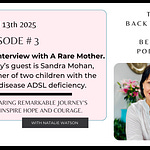In 2019, I met Nicole and her husband Justin Lytle after their second child was diagnosed with Adsl deficiency. Today I had the opportunity to interview Nicole to share a little of her family’s journey with Adsl deficiency.
Adenylosuccinate Lyase (ADSL) deficiency is a rare inherited disease of the Purine Metabolism associated with mutations in the ADSL gene. Also referred to as ADSLD.
The disease is characterised by 3 main phenotypes with symptoms that vary significantly among individuals and may include intellectual and movement challenges, autistic features, epilepsy, low muscle tone, and feeding difficulties.
Research has indicated that in most cases the following symptoms are apparent from infancy to early childhood..
Infantile spasms.
Unexplained pain/confused like crying episodes.
Mild to severe developmental delay.
Apraxia of speech. (Difficulty forming words)
Psychomotor retardation, Ataxic movement
Hypotonia
Joint and/or Limb pain/swelling, possibly related to purines in the diet.
Reduction in eye contact, light gazing, not tracking objects consistently, apparent vision disturbance.
Cortical Visual Impairment (CVA)
Autistic behaviours such as rocking, swaying, repetitive movements, self-stimulating and unregulated temper tantrums.
Twitching, jerks and vocal ticks.
Seizure disorders
Upon request, the disease can be detected through a ‘Bratton Marshall metabolic urine screen’ and an antenatal genetic screening.
Currently, there’s no treatment or cure for Adsl Deficiency, but there are ways to make life easier. Many families find relief with therapies like speech or physical therapy to support their child’s development—starting early can make a big difference! Medications can help manage symptoms like seizures and pain, fostering an environment where these amazing kids and their families have an opportunity to thrive despite their adversity.
Here’s Why I’m Inspired to Advocate & Connect
My two sons were diagnosed with this disease here in Australia in early 2011, at around the ages of 6 and 24 months by our neurologist at the Royal Children’s Hospital (RCH) hospital in Melbourne, Victoria. At the time of my boy’s diagnosis, there were believed to be only 40 reported cases in the world, and very little was known about the disease
As I was determined to learn as much as I could about the disease, I stumbled across two amazing blogs that shared their young families' heartbreaking journeys with Adsl deficiency. The personal stories of Adsl angels Ashley, Hope, and Hayden touched me so deeply that I made it my personal mission to find the other families diagnosed with the disease and become an advocate for anyone touched by the disease.
In 2014, I founded the first Adsl deficiency research and awareness public Facebook page and private group for families to connect personally.
While my boys are no longer here with us, I feel the deep desire to continue advocating and share the journeys of other families with a rare disease like Adsl deficiency.
Over the last few years, awareness of the disease has been increasing worldwide. Paediatric specialists and metabolic teams have witnessed an increase in the diagnosis rate, and our family Facebook group has also received more frequent requests to join our private group.
Whilst it’s bittersweet, I’m proud that we now have over 160 families sharing their journey with ADSL deficiency and that we have created our own community of support. Some of these families are sharing information and experiences through their own blogs, some are involved in fundraising, others connect with our research teams, provide DNA samples for medical data, and participate in treatment trials.

Adsl Deficiency Research and Awareness.
Our Mission ….
To continue funding our dedicated research scientists into the next phases of the Adsl Deficiency research project.
To continue to raise awareness of the disease throughout the world.
Advocate to find a treatment.
Advocate to find a cure.
To continue to educate, connect and support our families on their journey with Adsl deficiency.
To continue to advocate and seek the answers that will one day prevent another child and their family from the heart-breaking effects of this disease.
Please donate today to help us raise awareness of Adsl Deficiency.










Share this post